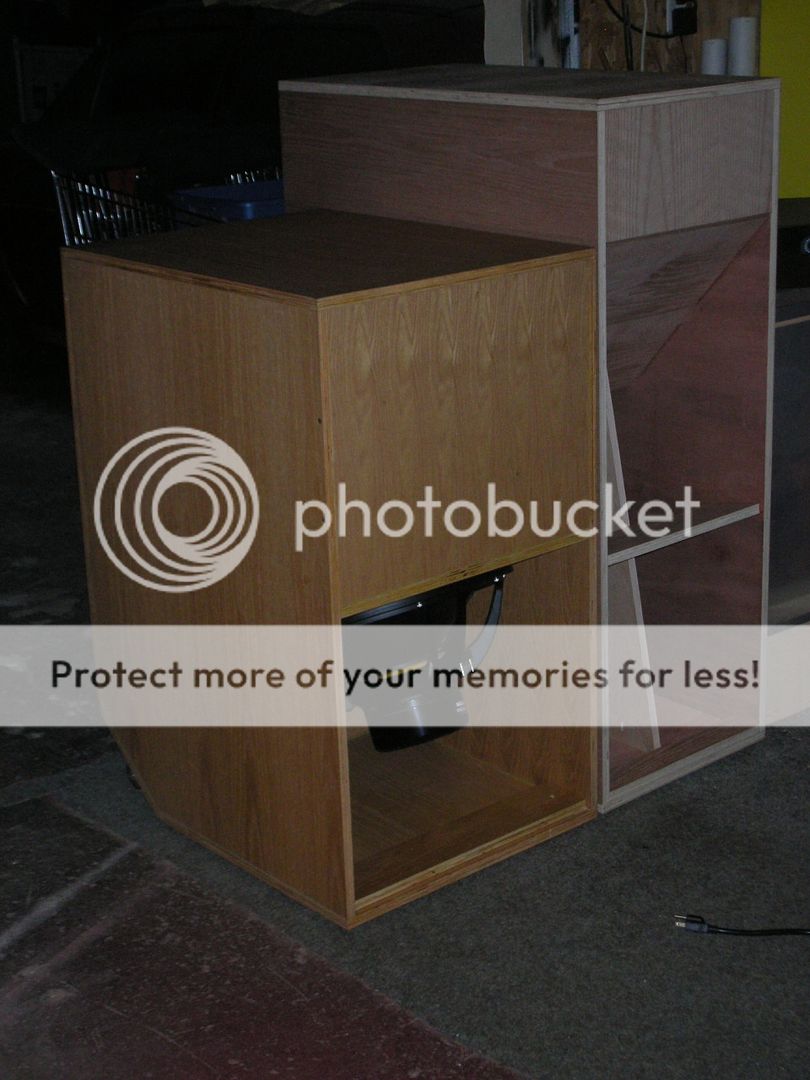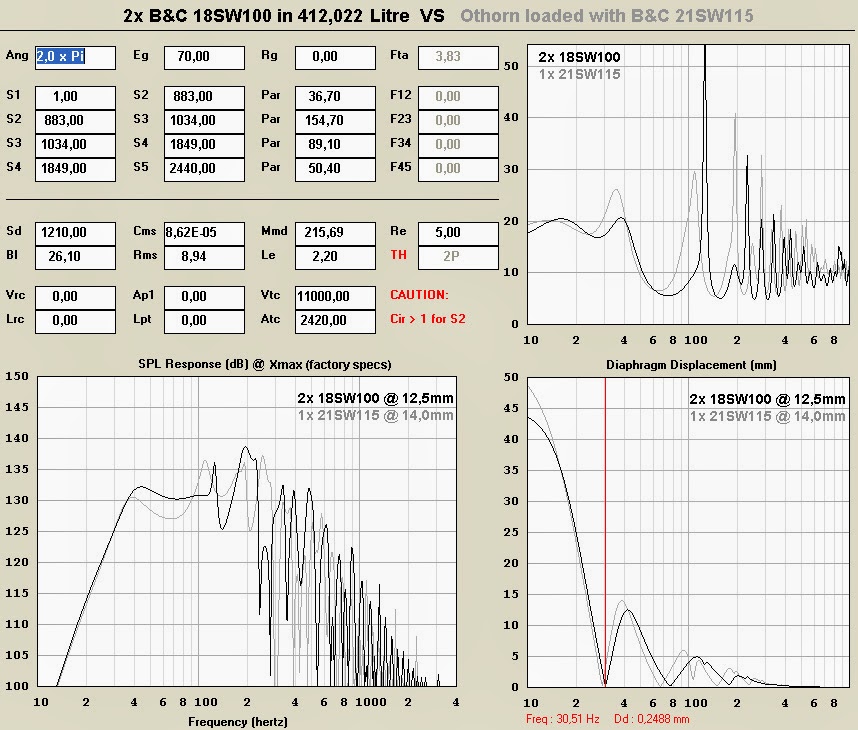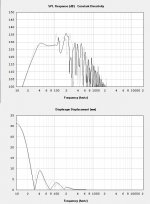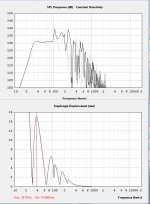Hi Andy1967,
Weltersys has a point that there are other alternatives since you have 'only'650Watts to power them. I see you live in Denmark and in that case you could also check out the 18Sound 18LW2400, RCF LF18G400 or RCF LF18G401. All these drivers can handle more power and sound great in the Xoc1-TH18.
You can use a B&C 18PS100 in a Xoc1-TH18 but watch out for the rms of the signal since it is a 700W driver with conventional mechanics.
Just make sure you use the correct cone correction, mouth reinforcement and sufficient bracing, otherwise you will loose decibels in output and cone stability below the tuning frequency. Since you have a DBX DriveRack PA I recommend using 24dB/oct or 36dB/oct High-Pass filter (and not 18dB/oct).
Perhaps you can give an idea for what kind of music/situation you are going to use your TH18's?
Thanks Djim,
I am planning to do both DJ'ing and live band with these 4 cabs + two top cabs with B&C15" + 2" HF driver on a 60x40 CD horn. 3 way active cross over with DBX. Amps are 'T-amp TA2400' and 'The amp d4-500'. Both amps should be replaced along the way.
I cannot find higher than 24db High Pass in the DBX Driverack PA+
If we leave the amps output out of the equation, what would be the best choice for my next two cabs?
I put the driver suggested by you and Weltersys and Dan side by side and wonder why my initial choice (4) in the sheet: B&C18SW100 is not the best? - apart from 18SW115 of cause

The mooving mass numbers look good and so does the VAS. What also I like about the B&C drivers is the fact that they claim that their xmax numbers are within 10% distortion, and that the cones are treated with a water resistant coating. (I wonder how much water they can take).
Regarding cone correction,
-I am still not understanding if the bigger volume cone correction:
1. The bigger compression?
2. Higher load?
3. So must be a choice based on the:
3.1 Strenght of the motor (BL?),
3.2 Cone material suspension etc.,
3.3 Excursion rates
3.4 Thermal capabilities?

Again thanks a lot for your time - it's very much appreciated
Andy
Here is a split representation of the volume of air in the cone when mounted to the baffle, and what it looks like when normalized to the width of a TH.

Cool
I guess this is the for the TH version 2?
/ Andy
15" is all you need at 650W IMO...
I have the 18SW115-4 and >250v RMS available, enough power to make the box move across a floor and try to climb the wall. IIRC I've got the filter at 25Hz 24dB slope. It'll handle more clean power than you are likely to buy.
And you don't sound the least worried if they can handle it
May I ask what kind of cone correction you have? Are your cabs version 1?
Regards, Andy
You should use a sine wave to set the voltage limit, exact frequency doesn't matter but probably somewhere below 100Hz to ensure accuracy of the volt meter - speaker disconnected if you have neighbours! A volt meter set on AC will do.Thanks TimLewis,
Do you know if a good normal voltmetre set on AC will do?
And what type of input? White noise?
And then I will have to model the driver to get the excursion graph?
-unless some one reading this has done this already? I know that CRESCENDO used the b&c18sw100 :0)
Thanks again, Andy
As this is a DIY design (the Bill Fitzmaurice designs have voltage limits already worked out so this removes most of the hard work), you may have to find the max displacement frequency yourself, either with an accurate model, or testing by eye.
I'm not sure of an exact method to measure displacement by eye apart from possibly a plastic spoon (or something that won't damage the cone) a set distance away and turning up till it slaps. You could measure at a lower voltage and scale up to Xmax if cranking the thing right up is too loud.
Alternatively Xoc1 might have worked out some voltage limits.
Or use a portal gun to fire a hole at both ends of the enclosure, mounting the driver in one end. This of course assumes no time delay in travelling through the portalThe trick is to hit the target for all three parameters length, expansion, and volume. I never said it was going to be a cake walk.
The low tech KISS method is to not fold, use two drivers and exit on both ends...
This is what I built, it is a little tighter in the back of the throat than the plans here.And you don't sound the least worried if they can handle it
May I ask what kind of cone correction you have? Are your cabs version 1?
Regards, Andy
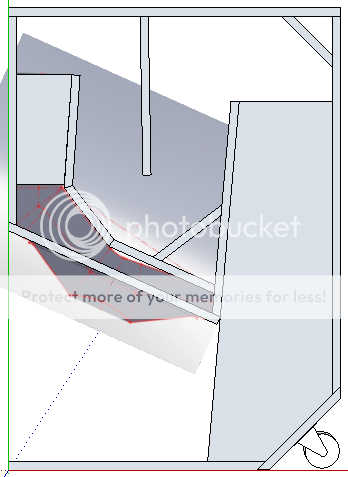
I have the ability to monitor in real time the actual power dissipated, pressure based excursion/servo and several other interesting data streams. And since power is nothing without control, there are some nice limiting options to keep things from getting ugly.
This is just a test box, I've learned a few things since then, and so now I am on the fence trying to make up my mind: B&C 21SW152-4, TC Sounds Pro-5100, or stick with the 18SW115-4. I have this level of power available for four cabinets.
This is just a test box, I've learned a few things since then, and so now I am on the fence trying to make up my mind: B&C 21SW152-4, TC Sounds Pro-5100, or stick with the 18SW115-4. I have this level of power available for four cabinets.
Is the mouth of your creation braced in any way? Even with my small POC TH, I noticed the panels flexing near the mouth. A few metal right-angle braces reduced the flexing a bit and strengthened the joints.
A diagonal cross-brace across the mouth would probably the most effective solution. But then it has to be removable in order to gain access to the driver. A metal grille could probably act as a brace, but could end up being a source of distortion BECAUSE it's acting as a brace
Hi Andy1967,If we leave the amps output out of the equation, what would be the best choice for my next two cabs?
I put the driver suggested by you and Weltersys and Dan side by side and wonder why my initial choice (4) in the sheet: B&C18SW100 is not the best? - apart from 18SW115 of cause.
The mooving mass numbers look good and so does the VAS. What also I like about the B&C drivers is the fact that they claim that their xmax numbers are within 10% distortion, and that the cones are treated with a water resistant coating. (I wonder how much water they can take).
Regarding cone correction, -I am still not understanding if the bigger volume cone correction:
I would always load the Xoc1-TH18 with the best drivers you can afford, even if you don’t use their maximum potential. If you have the finances for the 18SW100’s go for it, since these are awesome drivers!
Since you mentioned you are going to use it in mobile and open air situations, the maximum output efficiency from a standard European wall socket can become another consideration. What is often overlooked is that two TH18’s loaded with 'just' 9mm Xmax drivers, can give you 3dB more output from 'just' a 2400W amp, compared to one TH18 loaded with a superior 18mm Xmax driver powered by a 4800W amp. In other words more cabinets are always more efficient compared to less cabinets filled with 'superior' drivers.
Cone correction doesn’t increase the compression in relation to the original sim. The electrical parameters of a driver also don’t matter for cone correction. Cone correction is the physical compensation for the air-volume that is hidden in the cone. This 'extra' volume is not accounted for in models because in simulations cone shaped membranes do not exist. In simulation cones are threaded as 'perfect flat' membranes with the acoustic centre in the middle. But in a real built, this volume does exist and the acoustic centre is situated in the cone. This cone volume does not work like an acoustic chamber but is added to the horn (S2 area in HornResp).
Most Italian pro LF drivers are water resistant these days, so no worries there.
Hi NEO Dan,This is just a test box, I've learned a few things since then, and so now I am on the fence trying to make up my mind: B&C 21SW152-4, TC Sounds Pro-5100, or stick with the 18SW115-4. I have this level of power available for four cabinets.
For the same price, using dual 18SW115's in one enclosure, can beat a 21SW152 in efficiency and max output.
The mouth resonance is up ~200Hz, the braces did get rid of it.
I didn't like it though, it seems to interfere with the mouth, so out they came...
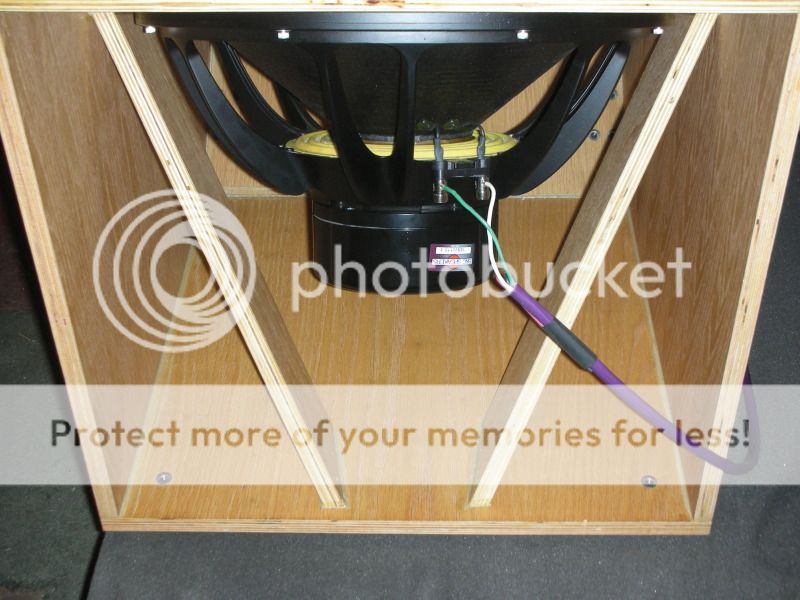
Hi Djim,
My pricing must be higher here:
2x 18SW115 + $170
2x 18SW100 + $71
And then there is additional shipping...
Do you think 2x 18SW100-8 could best a single 21SW152-4 loaded Othorn, all else being equal?
Regards,
Dan
I didn't like it though, it seems to interfere with the mouth, so out they came...

Hi Djim,
My pricing must be higher here:
2x 18SW115 + $170
2x 18SW100 + $71
And then there is additional shipping...
Do you think 2x 18SW100-8 could best a single 21SW152-4 loaded Othorn, all else being equal?
Regards,
Dan
The mouth resonance is up ~200Hz, the braces did get rid of it.
I didn't like it though, it seems to interfere with the mouth, so out they came...
That's curious - considering the cross-section of those braces, I'd have expected the effect on the FR to be negligible, unless the mouth size was small to begin with (and it doesn't appear to be so from the picture). Nice arrangement though - gives enough space for the driver to be passed through.
Hi Dan,... Do you think 2x 18SW100-8 could best a single 21SW152-4 loaded Othorn, all else being equal?...
Interesting question and not easy to answer since we lack relevant real data. I expect you ask from an EDM music style point of view, so comparisons are probably more relevant if the sine wave power is considered. With many 'Italians' the conventional Xmax formula: (Hvc-Hg)/2 is often used as guideline for sine wave power capabilities.
21SW152-4 = Xmax conv. = 10mm
Displacement is 1cm x 1680cm^2 = 1680cm^3
18SW100-8 = Xmax conv. = 9mm
For two drivers the displacement would be 1,9cm x 1210cm^2 = 2299cm^3
So, it looks in favour of the dual 18SW100's........but....
I think in the end the output of both systems will be very similar. The low tuning of the Othorn seems in favour of the 21SW115 with its lower FS and equals the advantages of the dual configuration in this situation.
So in short, I expect it will too close to call...
However, if you tune the dual driver TH a little higher (32Hz for instance) it might become more interesting to compare. Both systems are now 3Hz tuned below the Fs of the drivers and it wouldn’t surprise me if the slightly higher tuning would be fully compensated by the increase in efficiency.
Of course there will be a difference of 2 Hz in low cut, but would that matter somewhere around 25Hz?
Last edited:
Dan did this do a huge improvement on your resonating panel?
I ask because I saw this type of thing on my TH build a while ago.(different build) I do plan on building this TH18 in the coming months though.
And the Othorn does go a lot lower. The 6fold is closer to the Othorn and when using certain drivers does almost as well simulation wise. BUT after 40hz the TH18 pair is a monster compared to a Othorn. And I am not saying the Othorn is any slouch.
I ask because I saw this type of thing on my TH build a while ago.(different build) I do plan on building this TH18 in the coming months though.
And the Othorn does go a lot lower. The 6fold is closer to the Othorn and when using certain drivers does almost as well simulation wise. BUT after 40hz the TH18 pair is a monster compared to a Othorn. And I am not saying the Othorn is any slouch.
Djim, he was referencing the 21sw152, not the sw115, thus your 9mm vs 10 mm comparison should look a bit more like this. still gives the edge in output the sw100 pair, but the othorn doesnt look as slouchy with a big dip any more, and true f3 of 28hz
and your max spl should look like second pic (the s1sw152 showing it stuff with its 15mm xmax, closing the gap )
and your max spl should look like second pic (the s1sw152 showing it stuff with its 15mm xmax, closing the gap )
Attachments
Last edited:
no worries, I happened to have run the othorn sim with a number of drivers (21sw152, 21sw150, 21sw115, TC 18 pro 5400, 18sw115, 18tbw100) so I saw the variation in your graph before I even got around to reading your post!
I've edited my above pictures to show "max spl" as well.
Bottom line, will you hear the 1db more output between 40 and 50hz shown int he 18sw100 pair? Will you hear the 7 hz more extension from the othorn (3 semitones)? I tend to lean towards the latter, although t 18sw100 pair (with 70 v in to 2 8 ohm drivers in p) may indeed suffer from less power compression than the 21sw152 when hit with 90v (into 4 ohms), which may rob the sw152 from output below its 2nd impedance spike at 39hz.
I've edited my above pictures to show "max spl" as well.
Bottom line, will you hear the 1db more output between 40 and 50hz shown int he 18sw100 pair? Will you hear the 7 hz more extension from the othorn (3 semitones)? I tend to lean towards the latter, although t 18sw100 pair (with 70 v in to 2 8 ohm drivers in p) may indeed suffer from less power compression than the 21sw152 when hit with 90v (into 4 ohms), which may rob the sw152 from output below its 2nd impedance spike at 39hz.
Last edited:
- Home
- Loudspeakers
- Subwoofers
- TH-18 Flat to 35hz! (Xoc1's design)
